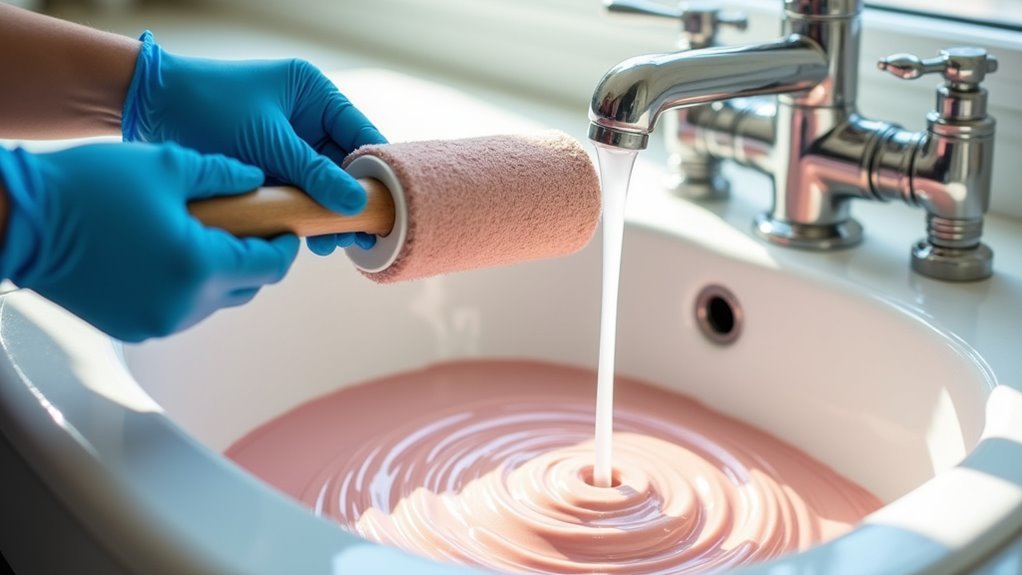We've all faced that moment – looking at a paint-covered roller and wondering what to do next. While it might seem easier to throw it away and buy a new one, cleaning your roller properly saves money and makes it last longer. Learning how to clean paint rollers is simpler than you might think, whether you're using water-based or oil-based paints.
Some of the links in this article may be affiliate links. If you make a purchase through these links, we may earn a small commission at no extra cost to you. Thank you.
According to Bob Vila, a home improvement expert and TV host, "A quality roller frame and cover, when properly cleaned and stored, can be reused dozens of times before needing replacement."
Think of cleaning your paint roller like washing your hair – you need to rinse out all the paint (like shampoo) until the water runs clear. Just like you wouldn't want leftover shampoo in your hair, you don't want dried paint stuck in your roller. These simple cleaning steps will keep your painting tools ready for your next project, and you won't have to keep buying new ones.
Smart Paint Cleanup

While cleaning paint rollers might seem like a tedious task, it's one of the most important steps in maintaining your painting tools.
Taking care of your painting tools may be time-consuming, but proper maintenance ensures they'll serve you well for years.
When we're working with latex paint, we'll want to use warm, soapy water and massage the fibers thoroughly.
For oil-based paint, we'll need mineral spirits instead.
Remember to rinse until the cleaning solution runs clear, and always dispose of waste properly.
##
Let's look at the essential points we need to know about cleaning paint rollers, from the must-do steps to common mistakes we should avoid.
When we're working with paint rollers, proper cleaning techniques can make the difference between having a roller we can reuse and one we'll need to throw away.
We'll walk through the cleaning process step-by-step, share some helpful tips for both latex and oil-based paints, and highlight the importance of timing in roller maintenance.
Things to Do When Cleaning a Paint Roller
Properly cleaning your paint rollers after use is essential for maintaining their quality and ensuring they're ready for your next painting project.
The cleaning process varies depending on the type of paint used, but thorough cleaning not only extends the life of your rollers but also prevents dried paint from affecting future paint applications and maintains the smooth finish you desire in your paint jobs.
- Remove excess paint – Scrape off as much paint as possible back into the paint can using a putty knife or roller scraper.
- Choose appropriate cleaning solution – Use warm water for latex paint or mineral spirits for oil-based paint.
- Initial rinse – Run roller under cleaning solution to remove surface paint.
- Deep clean – Work cleaning solution into the roller fibers, squeezing and massaging to release trapped paint.
- Thorough rinse – Continue rinsing until water or solvent runs completely clear.
- Spin dry – Use a roller spinner or spin by hand to remove excess moisture.
- Air dry completely – Stand roller on end in a well-ventilated area until thoroughly dry.
- Store properly – Keep in a dust-free location or wrap in plastic if using again soon.
Things to Avoid When Cleaning a Paint Roller
When cleaning paint rollers, it's essential to avoid common mistakes that can damage the tool or harm the environment. Proper care guarantees the longevity of your paint rollers and maintains their effectiveness for future projects, while also protecting water systems and following local regulations for proper disposal of painting materials.
- Using scalding hot water – Damages latex roller fibers and compromises the roller's ability to hold and distribute paint evenly.
- Water-cleaning oil-based rollers – Causes paint to harden within the fibers, making the roller unusable and cleanup more difficult.
- Harsh chemical cleaners – Can break down roller materials and reduce their effectiveness over time.
- Aggressive scrubbing – Damages the roller's nap and creates an uneven surface that affects future paint application.
- Improper disposal – Dumping cleaning solutions in storm drains pollutes water systems and violates environmental regulations.
- Prolonged soaking – Weakens adhesives and can cause the roller cover to separate from its core.
- Drying in direct sunlight – Can cause warping and deterioration of the roller material.
Steps
Cleaning a paint roller properly is essential for maintaining its quality and ensuring it's ready for future use.
The cleaning process varies slightly depending on whether you used latex or oil-based paint, but the fundamental steps remain similar and focus on thoroughly removing all paint residue while preserving the roller's fiber integrity.
Step 1: Remove the roller cover from the frame
Step 2: Scrape off excess paint using a putty knife
Step 3: Fill a bucket with warm soapy water for latex paint or mineral spirits for oil-based paint
Step 4: Submerge the roller in the cleaning solution
Step 5: Massage the roller with your hands to work the solution into the fibers
Step 6: Rinse thoroughly with clean water until it runs clear
Step 7: Use a roller spinner to remove excess water (optional)
Step 8: Stand the roller upright on its end
Step 9: Allow the roller to air dry completely before storage
Final Thoughts
Taking good care of your paint rollers isn't just about cleaning them – it's about maximizing their lifespan and ensuring quality results in your future painting projects.
When we're diligent about cleaning a roller with clean water after each paint job, we're not only saving money in the long run but also maintaining the tools that help us achieve professional-looking results in all our painting endeavors.
##

Proper paint roller maintenance is essential for both the quality of your paint jobs and the longevity of your tools.
By taking a few minutes to clean your rollers immediately after use, you'll save money on replacement supplies and guarantee better results in your future painting projects.
Remember that different types of paint require different cleaning methods, and always dispose of cleaning materials responsibly.
With these cleaning techniques in your arsenal, you can keep your paint rollers in top condition and ready for the next project.
Start implementing these practices today – your paint rollers and your wallet will thank you.






